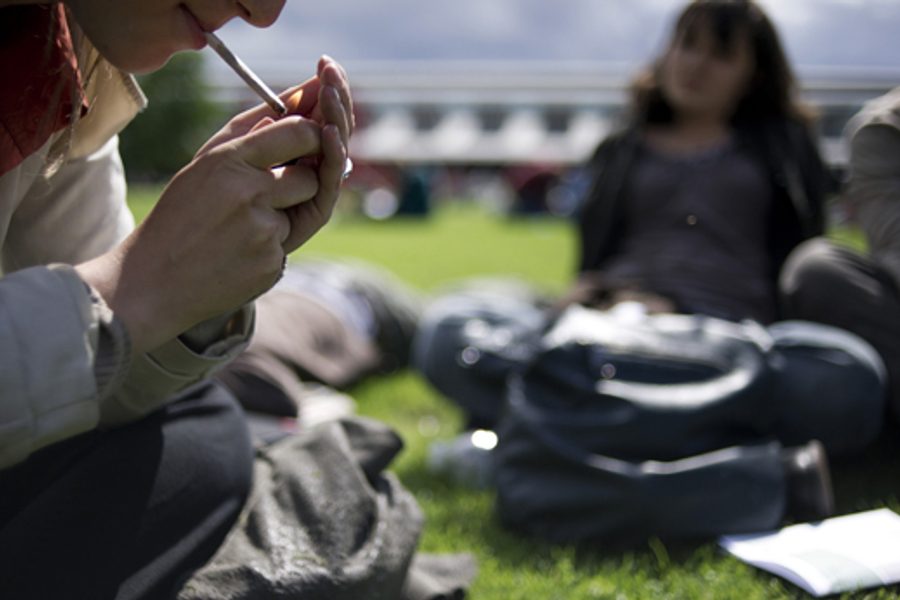University of Hypocrisy
Why do America’s colleges celebrate drinking alcohol but have no tolerance for marijuana?
David Sirota

In the firmament of celebrated Americana, there is Mom, apple pie, football and beer — but there most certainly is not marijuana. As it relates to drugs, this bizarre culture has us implicitly accepting that people will inevitably use mind-altering substances. But through our statutes, we allow law-abiding citizens to use only one recreational substance — alcohol — that just happens to be way more hazardous than pot.
Such idiocy is the product of many variables. There’s been interest-group maneuvering and temperance-movement hypocrisy. There’s been hippie-hating rage and reefer-madness paranoia. And, most invisibly, there’s been college.
Though little noticed for its role in America’s selective War on Drugs, the university system has now become a key player shotgunning the oxymoronic “alcohol is acceptable but pot is evil” mentality down the beer-bong-primed throats of America’s youth. To see how it all works, consider the University of Colorado (CU).
Both figuratively and literally immersed in alcohol, CU is the higher education gem of a state whose governor famously made his millions on beer breweries. Today, the school’s catering service sells alcohol, and university officials license CU’s logo for use on beer-drinking merchandise. Meanwhile, every school year, CU forces kids to sit through a convocation in a beer-themed arena — the Coors Events Center — to learn about the “meaning and responsibilities” of student life.
Unsurprisingly, CU now has a binge-drinking problem, as evidenced by last week’s news that another CU student died after a night of heavy imbibing.
This headline-grabbing tragedy — CU’s second such fatality in less than a decade — is but one of the 600,000 alcohol-related student injuries each year, according to the National Institute on Alcohol Abuse and Alcoholism. But because, like other schools, CU is intertwined with alcohol culture, the university has danced around the issue, simultaneously acknowledging the problem and not doing much about it.
“(Alcohol) is the cause or primary factor in (a majority) of suicides, unintentional deaths, physical injuries, distressed personal relationships, legal problems, sexual assault, property damage and academic failure,” admitted Donald Misch, CU’s assistant vice chancellor for health and wellness, in 2010.
Yet, Misch refrained from an abstinence message, imploring students to “drink responsibly.”
This libertarian attitude seems laudable for acknowledging the fact that kids will party regardless of prohibitionist rules. However, it is counterproductive in the context of the school’s no-tolerance posture toward marijuana — a substance that has been connected to far fewer injuries and no overdoses.
In recent years, the Boulder Daily Camera newspaper reports, university regents have been looking to “crack down” on students’ unsanctioned “4÷20” pro-pot protest because officials say it gives the school a “party image” — as if CU’s beer-soaked tailgating festivities don’t do that already. While students over 21 may possess alcohol in university residences, according to the Camera, “CU bans marijuana in its dorms, even if students have medical licenses.” And whereas underage drinking typically results in soft punishments from university officials, CU campus police have been increasing citations for marijuana possession, which can result in students losing financial aid.
CU, of course, embodies the norm in our universities, almost all of which issue harsher penalties for marijuana possession than alcohol use. Though students at more than a dozen schools across the country recently voted for referenda demanding administrators equalize punishments, the initiatives have been ignored. Instead, school officials are fighting to instill America’s destructive drug-war mentality in the next generation.
The result is the perpetuation of a destructive ethos that encourages us to party hard — but only with a substance that is far more toxic than marijuana.
SPECIAL DEAL: Subscribe to our award-winning print magazine, a publication Bernie Sanders calls "unapologetically on the side of social and economic justice," for just $1 an issue! That means you'll get 10 issues a year for $9.95.
David Sirota is an award-winning investigative journalist and an In These Times senior editor. He served as speechwriter for Bernie Sanders’ 2020 campaign. Follow him on Twitter @davidsirota.







